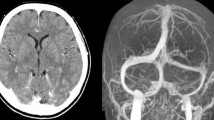Abstract
Postpartum angiopathy as clinical presentation of reversible cerebral vasoconstriction syndrome remains an intriguing phenomenon. The diagnosis needs to be considered in women presenting with thunderclap headache with or without associated neurological deficits. Here, we present a patient with thunderclap headache with initial normal laboratory and cerebral imaging findings, including intracranial angiography. Her condition worsened over several days and magnetic resonance imaging revealed changes initially compatible with posterior reversible encephalopathy syndrome, sequentially ischemic stroke and narrowing of the intracranial arteries. Although the patient was in coma for several days, she completely recovered and the focal vasoconstriction fully resolved. This case underscores the complex and variable presentation of postpartum angiopathy and illustrates the diagnosis to be (re)considered even if cerebral vasoconstriction is not documented at the onset of symptoms.


Similar content being viewed by others
References
Calabrese LH et al (2007) Narrative review: reversible cerebral vasoconstriction syndromes. Ann Intern Med 146(1):34–44
Call GK et al (1988) Reversible cerebral segmental vasoconstriction. Stroke 19(9):1159–1170
Ducros A et al (2007) The clinical and radiological spectrum of reversible cerebral vasoconstriction syndrome. A prospective series of 67 patients. Brain 130(Pt 12):3091–3101
Williams TL et al (2007) A fatal case of postpartum cerebral angiopathy with literature review. Arch Gynecol Obstet 275(1):67–77
Chen SP et al (2008) Transcranial color doppler study for reversible cerebral vasoconstriction syndromes. Ann Neurol 63(6):751–757
Chen SP, Fuh JL, Wang SJ (2010) Reversible cerebral vasoconstriction syndrome: an under-recognized clinical emergency. Ther Adv Neurol Disord 3(3):161–171
Singhal AB et al (2011) Reversible cerebral vasoconstriction syndromes: analysis of 139 cases. Arch Neurol 68(8):1005–1012
Ducros A, Bousser MG (2009) Reversible cerebral vasoconstriction syndrome. Pract Neurol 9(5):256–267
Ursell MR et al (1998) Recurrent intracranial hemorrhage due to postpartum cerebral angiopathy: implications for management. Stroke 29(9):1995–1998
Konstantinopoulos PA et al (2004) Postpartum cerebral angiopathy: an important diagnostic consideration in the postpartum period. Am J Obstet Gynecol 191(1):375–377
Neudecker S, Stock K, Krasnianski M (2006) Call–Fleming postpartum angiopathy in the puerperium: a reversible cerebral vasoconstriction syndrome. Obstet Gynecol 107(2 Pt 2):446–449
Chik Y et al (2009) A case of postpartum cerebral angiopathy with subarachnoid hemorrhage. Nat Rev Neurol 5(9):512–516
Singhal AB (2004) Postpartum angiopathy with reversible posterior leukoencephalopathy. Arch Neurol 61(3):411–416
Muhlenbruch G et al (2010) Comparison of dual-source CT angiography and MR angiography in preoperative evaluation of intra- and extracranial vessels: a pilot study. Eur Radiol 20(2):469–476
Phan TG et al (2007) Digital map of posterior cerebral artery infarcts associated with posterior cerebral artery trunk and branch occlusion. Stroke 38(6):1805–1811
Bartynski WS (2008) Posterior reversible encephalopathy syndrome, part 2: controversies surrounding pathophysiology of vasogenic edema. Am J Neuroradiol 29(6):1043–1049
Acknowledgments
Robin Lemmens is supported by Research Fund KU Leuven. Vincent Thijs is a Senior Clinical Investigator of FWO Flanders.
Conflict of interest
None.
Author information
Authors and Affiliations
Corresponding author
Rights and permissions
About this article
Cite this article
Lemmens, R., Smet, S., Wilms, G. et al. Postpartum RCVS and PRES with normal initial imaging findings. Acta Neurol Belg 112, 189–192 (2012). https://doi.org/10.1007/s13760-012-0051-z
Received:
Accepted:
Published:
Issue Date:
DOI: https://doi.org/10.1007/s13760-012-0051-z




